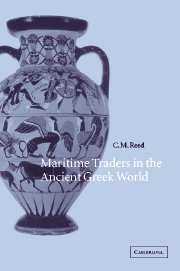Book contents
- Frontmatter
- Contents
- Acknowledgments
- List of abbreviations
- List of references to Greek terms
- Maps
- Introduction
- Chapter 1 Coming to terms
- Chapter 2 Classical modes and patterns of exchange
- Chapter 3 The juridical place of maritime traders
- Chapter 4 The level of wealth of maritime traders
- Chapter 5 Official attitudes towards maritime traders
- Chapter 6 Unofficial attitudes toward maritime traders
- Chapter 7 Archaic modes of exchange and the personnel involved c. 800–475 b.c.
- Chapter 8 Conclusion: then and now
- Appendix 1 Emporoi and nauklēroi: their attested states of origin
- Appendix 2 Cohesion among maritime traders
- Appendix 3 The dikai emporikai
- Appendix 4 Catalogue of emporoi and nauklēroi
- Bibliography
- Index locorum
- General index
Chapter 4 - The level of wealth of maritime traders
Published online by Cambridge University Press: 22 September 2009
- Frontmatter
- Contents
- Acknowledgments
- List of abbreviations
- List of references to Greek terms
- Maps
- Introduction
- Chapter 1 Coming to terms
- Chapter 2 Classical modes and patterns of exchange
- Chapter 3 The juridical place of maritime traders
- Chapter 4 The level of wealth of maritime traders
- Chapter 5 Official attitudes towards maritime traders
- Chapter 6 Unofficial attitudes toward maritime traders
- Chapter 7 Archaic modes of exchange and the personnel involved c. 800–475 b.c.
- Chapter 8 Conclusion: then and now
- Appendix 1 Emporoi and nauklēroi: their attested states of origin
- Appendix 2 Cohesion among maritime traders
- Appendix 3 The dikai emporikai
- Appendix 4 Catalogue of emporoi and nauklēroi
- Bibliography
- Index locorum
- General index
Summary
INTRODUCTION
How wealthy, by comparison with those in the “upper class” of Greek poleis, were the emporoi and nauklēroi trading at Athens or elsewhere? By definition (see 12–13) a nauklēros not only owned a merchant ship, one of which brought forty minae when sold in the fourth century ([D.] 33.12); he may have normally owned a slave crew as well: “Demosthenes' matter-of-fact allusions [[D.] 33.8–10; 34.10] to seagoing freighters manned by slaves shows how common the practice must have been in the fourth century b.c.” (Casson [1971: 328]). A single ship and slave crew would make a nauklēros moderately wealthy, but the term “wealthy” applied here to nauklēroi refers only to those who were more than moderately wealthy. The following nauklēroi in the Catalogue appear to fall into this latter category: Lampis I (no. 2), possibly Apollonides (no. 17), Phormion II (no. 23), probably Philippos (no. 25), Andokides (no. 41), and Herakleides (no. 60). Three of these – Lampis I, Phormion II, and (possibly) Andokides – are the only nauklēroi said to own more than one vessel.
As for emporoi, Hasebroek cites [D.] 34.51 to support his claim that “merchants and shipowners … were invariably without any capital worth mentioning of their own.” In [D.] 34.51 a bottomry lender predictably claims that “the means for engaging in trade come not from those who borrow but from those who lend, and no ship, no shipowner, and no passenger can put to sea without the help of the lenders.”
- Type
- Chapter
- Information
- Maritime Traders in the Ancient Greek World , pp. 34 - 42Publisher: Cambridge University PressPrint publication year: 2003



